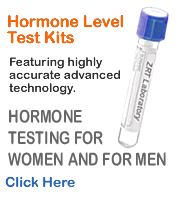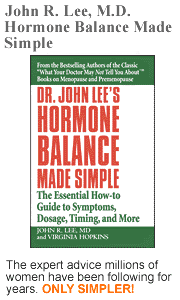|
|
||||
|
For suggestions on how to find a doctor in your area, please go to:  |
||||
|
Bioidentical Hormones: Dr. John R. Lee's Three Rules for BHRT |
||||
Use a sprinkle of common sense and a dash of logic. by John R. Lee, M.D. The recent Lancet publication of the Million Women Study (MWS) removes any lingering doubt that there's something wrong with conventional HRT (see Million Woman Study in the UK, Published in The Lancet, Gives New Insight into HRT and Breast Cancer for details). Why would supplemental estrogen and a progestin (e.g. not real progesterone) increase a woman's risk of breast cancer by 30 percent or more? Other studies found that these same synthetic HRT hormones increase one's risk of heart disease and blood clots (strokes), and do nothing to prevent Alzheimer's disease. When you pass through puberty and your sex hormones surge, they don't make you sick—they cause your body to mature into adulthood and be healthy. But, the hormones used in conventional HRT are somehow not right—they are killing women by the tens of thousands. The question is—where do we go from here? My answer is—we go back to the basics and find out where our mistake is. I have some ideas on that. Over the years I have adopted a simple set of three rules covering hormone supplementation. When these rules are followed, women have a decreased risk of breast cancer, heart attacks, or strokes. They are much less likely to get fat, or have poor sleep, or short term memory loss, fibrocystic breasts, mood disorders or libido problems. And the rules are not complicated. Rule 1. Give hormones only to those who are truly deficient in them. The first rule is common sense. We don't give insulin to someone unless we have good evidence that they need it. The same is true of thyroid, cortisol and all our hormones. Yet, conventional physicians routinely prescribe estrogen or other sex hormones without ever testing for hormone deficiency. Conventional medicine assumes that women after menopause are estrogen-deficient. This assumption is false. Twenty-five years ago I reviewed the literature on hormone levels before and after menopause, and all authorities agreed that over two-thirds (66 percent) of women up to age 80 continue to make all the estrogen they need. Since then, the evidence has become stronger. Even with ovaries removed, women make estrogen, primarily by an aromatase enzyme in body fat and breasts that converts an adrenal hormone, androstenedione, into estrone. Women with plenty of body fat may make more estrogen after menopause than skinny women make before menopause. Breast cancer specialists are so concerned about all the estrogen women make after menopause that they now use drugs to block the aromatase enzyme. Consider the irony: some conventional physicians are prescribing estrogens to treat a presumed hormone deficiency in postmenopausal women, while others are prescribing drugs that block estrogen production in postmenopausal women. How does one determine if estrogen deficiency exists? Any woman still having monthly periods has plenty of estrogen. Vaginal dryness and vaginal mucosal atrophy, on the other hand, are clear signs of estrogen deficiency. Lacking these signs, the best test is the saliva hormone assay. With new and better technology, saliva hormone testing has become accurate and reliable. As might be expected, we have learned that hormone levels differ between individuals; what is normal for one person is not necessarily normal for another. Further, one must be aware that hormones work within a complex network of other hormones and metabolic mediators, something like different musicians in an orchestra. To interpret a hormone s level, one must consider not only its absolute level but also its relative ratios with other hormones that include not only estradiol, progesterone and testosterone, but cortisol and thyroid as well. For example, in healthy women without breast cancer, we find that the saliva progesterone level routinely is 200 to 300 times greater than the saliva estradiol level. In women with breast cancer, the saliva progesterone/estradiol ratio is considerably less than 200 to 1. As more investigators become more familiar with saliva hormone tests, I believe these various ratios will become more and more useful in monitoring hormone supplements. Serum or plasma blood tests for steroid hormones should be abandoned—the results so obtained are essentially irrelevant. Steroid hormones are extremely lipophilic (fat-loving) and are not soluble in serum. Steroid hormones carry their message to cells by leaving the blood flow at capillaries to enter cells where they bond with specific hormone receptors in order to convey their message to the cells. These are called “free” hormones. When eventually they circulate through the liver, they become protein-bound (enveloped by specific globulins or albumin), a process that not only seriously impedes their bioavailability but also makes them water soluble, thus facilitating their excretion in urine. Measuring the concentration of these non-bioavailable forms in urine or serum is irrelevant since it provides no clue as to the concentration of the more clinically significant “free“ (bioavailable) hormone in the blood stream. When circulating through saliva glands, the “free” non–protein-bound steroid hormone diffuses easily from blood capillaries into the saliva gland and then into saliva. Protein-bound, non-bioavailable hormones do not pass into or through the saliva gland. Thus, saliva testing is far superior to serum or urine testing in measuring bioavailable hormone levels. Serum testing is fine for glucose and proteins but not for measuring “free” steroid hormones. Fifty years of “blood” tests have led to the great confusion that now befuddles conventional medicine in regard to steroid hormone supplementation. Rule 2. Use bioidentical hormones rather than synthetic hormones. The second rule is also just common sense. The message of steroid hormones to target tissue cells requires bonding of the hormone with specific unique receptors in the cells. The bonding of a hormone to its receptor is determined by its molecular configuration, like a key is for a lock. Synthetic hormone molecules and molecules from different species (e.g. Premarin, which is from horses) differ in molecular configuration from endogenous (made in the body) hormones. From studies of petrochemical xenohormones, we learn that substitute synthetic hormones differ in their activity at the receptor level. In some cases, they will activate the receptor in a manner similar to the natural hormone, but in other cases the synthetic hormone will have no effect or will block the receptor completely. Thus, hormones that are not bioidentical do not provide the same total physiologic activity as the hormones they are intended to replace, and all will provoke undesirable side effects not found with the human hormone. Human insulin, for example, is preferable to pig insulin. Sex hormones identical to human (bioidentical) hormones have been available for over 50 years. Pharmaceutical companies, however, prefer synthetic hormones. Synthetic hormones (not found in nature) can be patented, whereas real (natural, bioidentical) hormones can not. Patented drugs are more profitable than non-patented drugs. Sex hormone prescription sales have made billions of dollars for pharmaceutical companies Thus is women's health sacrificed for commercial profit. Rule 3. Use only in dosages that provide normal physiologic tissue levels. The third rule is a bit more complicated. Everyone would agree, I think, that dosages of hormone supplements should restore normal physiologic levels. The question is—how do you define normal physiologic levels? Hormones do not work by just floating around in circulating blood; they work by slipping out of blood capillaries to enter cells that have the proper receptors in them. As explained above, protein-bound hormones are unable to leave blood vessels and bond with intracellular receptors. They are non-bioavailable. But they are water-soluble, and thus found in serum, whereas the “free” bioavailable hormone is lipophilic and not water soluble, thus not likely to be found in serum. Serum tests do not help you measure the “free,” bioavailable form of the hormone. The answer is saliva testing. It is quite simple to measure the change in saliva hormone levels when hormone supplementation is given. If more physicians did that, they would find that their usual estrogen dosages create estrogen levels 8 to 10 times greater than found in normal healthy people, and that progesterone levels are not raised by giving supplements of synthetic progestin such as medroxyprogesterone acetate (MPA). Further, saliva levels (and not serum levels) of progesterone will clearly demonstrate excellent absorption of progesterone from transdermal creams. Transdermal progesterone enters the bloodstream fully bioavailable (i.e., without being protein-bound). The progesterone increase is readily apparent in saliva testing, whereas serum will show little or no change. In fact, any rise of serum progesterone after transdermal progesterone dosing is most often a sign of excessive progesterone dosage. Saliva testing helps determine optimal dosages of supplemented steroid hormones, something that serum testing cannot do. It is important to note that conventional HRT violates all three of these rules for rational use of supplemental steroid hormones. A 10-year French study of HRT using a low-dose estradiol patch plus oral progesterone shows no increased risk of breast cancer, strokes or heart attacks. Hormone replacement therapy is a laudable goal, but it must be done correctly. HRT based on correcting hormone deficiency and restoring proper physiologic balanced tissue levels, is proposed as a more sane, successful and safe technique. Other Factors Hormone imbalance is not the only cause of breast cancer, strokes, and heart attacks. Other risk factors of importance include the following:
Men share these risks equally with women. Hormone imbalance and exposure to these risk factors in men leads to earlier heart attacks, lower sperm counts and higher prostate cancer risk. Conclusion Conventional hormone replacement therapy (HRT) composed of either estrone or estradiol, with or without progestins (excluding progesterone) carries an unacceptable risk of breast cancer, heart attacks and strokes. I propose a more rational HRT using bioidentical hormones in dosages based on true needs as determined by saliva testing. In addition to proper hormone balancing, other important risk factors are described, all of which are potentially correctable. Combining hormone balancing with correction of other environmental and lifestyle factors is our best hope for reducing the present risks of breast cancer, strokes and heart attacks. A much broader discussion of all these factors can be found in the updated and revised edition of What Your Doctor May Not Tell You About Menopause and What Your Doctor May Not Tell You About Breast Cancer.
|
||||




